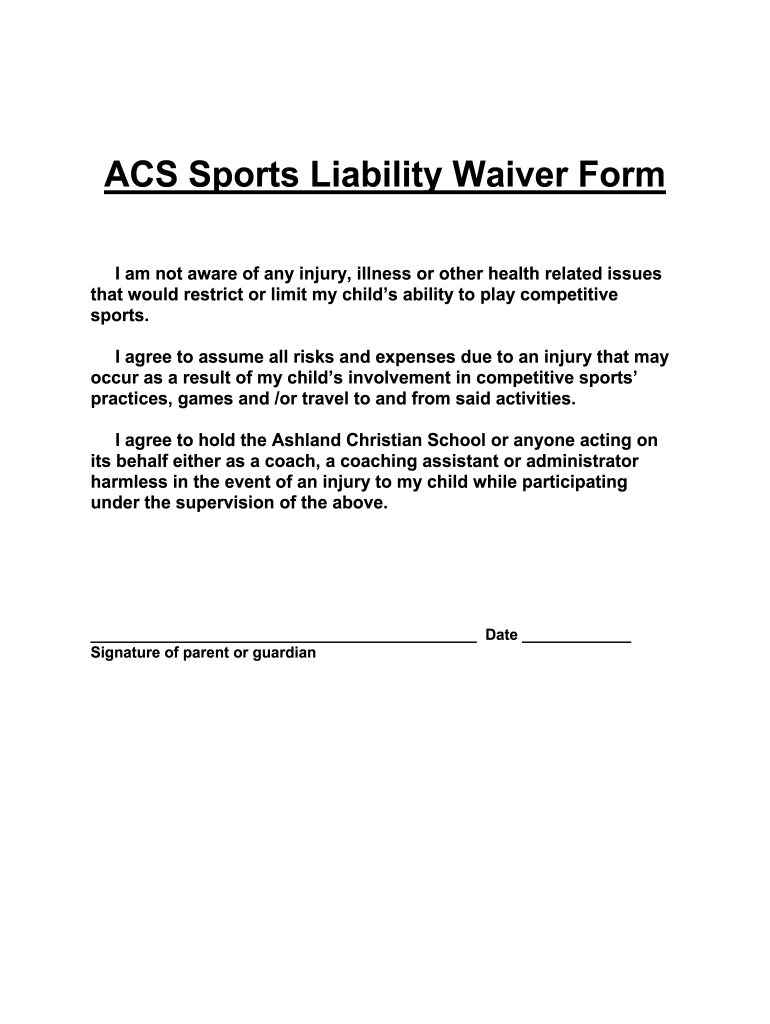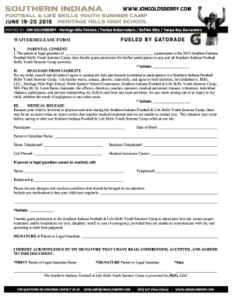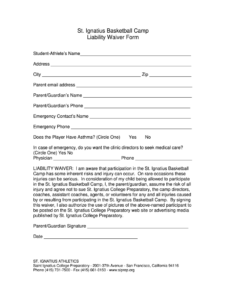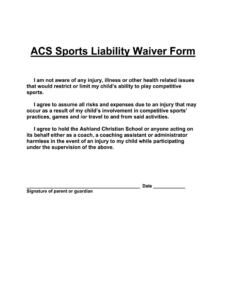Utilizing such forms offers significant protection for athletic programs. By clearly outlining the potential hazards and securing informed consent, organizations can mitigate legal exposure. These forms also serve to educate parents and guardians about the inherent risks involved in the activities, fostering a shared understanding and promoting a safer environment for all participants.
This article will further explore key components typically included in such documents, address common legal considerations, and offer best practices for implementation and management.

Key Components of a Youth Sports Waiver
Several essential elements ensure the comprehensiveness and effectiveness of waivers for athletic programs involving minors. These components work together to protect both the organization and the participants.
1. Participant Information: Full legal names and dates of birth of the minor participant and the signing parent or guardian are crucial for accurate record-keeping and identification.
2. Activity Description: A clear and concise description of the specific sport or activity, including the duration and location of participation, helps define the scope of the waiver.
3. Risk Acknowledgment: This section explicitly outlines the inherent risks associated with the activity, ranging from minor injuries like sprains and bruises to more serious risks like concussions or fractures. Specificity is critical here.
4. Liability Release: This clause states that the parent or guardian agrees to release the organization, its staff, and volunteers from liability for injuries sustained during participation, except in cases of gross negligence or intentional misconduct.
5. Medical Consent: This component grants permission for the organization to administer emergency medical treatment if necessary. Contact information for the participant’s physician and insurance details should also be included.
6. Rules and Regulations: A statement acknowledging agreement to abide by the program’s rules and regulations reinforces expectations for conduct and participation.
7. Severability Clause: This clause ensures that if any part of the waiver is deemed unenforceable, the remaining provisions remain valid.
8. Signature and Date: The document must be signed and dated by the parent or guardian to signify informed consent and agreement to the terms.
Careful consideration of these components ensures a well-drafted document that provides important legal protections and fosters a clear understanding between the organization and participating families. A comprehensive waiver helps establish a framework for responsible participation and risk management within youth sports programs.
How to Create a Youth Sports Waiver Template
Developing a robust waiver template requires careful attention to legal considerations and specific activity-related risks. A well-crafted document protects the organization and informs participants of potential hazards.
1. Consult Legal Counsel: Legal expertise is crucial to ensure compliance with applicable state and local laws. An attorney specializing in liability and waivers can provide guidance tailored to the specific circumstances of the organization and its activities.
2. Define Scope and Purpose: Clearly identify the specific sport or activity the waiver covers. This ensures that the risks outlined are relevant and the release of liability applies directly to the intended activity.
3. Detail Inherent Risks: Specify the potential hazards associated with the sport or activity, ranging from common injuries to more serious possibilities. Comprehensive risk disclosure is crucial for informed consent.
4. Craft Clear Language: Use unambiguous language that is easily understood by the average person. Avoid complex legal jargon that could create confusion or misinterpretations.
5. Include Essential Components: Ensure the document includes all necessary elements: participant information, activity description, risk acknowledgment, liability release, medical consent, rules and regulations acknowledgment, severability clause, and signature lines.
6. Tailor to Specific Activities: One template may not fit all. Adapt the waiver to reflect the unique risks associated with different sports or activities offered by the organization.
7. Periodic Review and Updates: Regularly review the waiver template with legal counsel to ensure it remains current with evolving legal requirements and adequately addresses any new risks.
Methodical creation of a waiver template, incorporating these steps, is essential for risk management within youth sports organizations. This proactive approach ensures compliance and fosters a safer environment for participants while protecting the organization from potential liability.
Careful development and implementation of legally sound waivers are essential for youth sports organizations. Understanding the key components, legal considerations, and best practices for creating and utilizing these documents provides crucial risk mitigation for organizations and promotes a safer environment for young athletes. This overview has highlighted the importance of clear language, comprehensive risk disclosure, and informed consent in fostering a balance between promoting youth athletic participation and protecting organizations from potential liability.
Prioritizing the development of robust waiver templates and procedures demonstrates a commitment to safety and responsible program management. Regular review and adaptation of these documents in consultation with legal counsel are critical to navigating the evolving legal landscape and ensuring the continued protection of both organizations and participants. This proactive approach strengthens the foundation upon which youth sports programs thrive.



